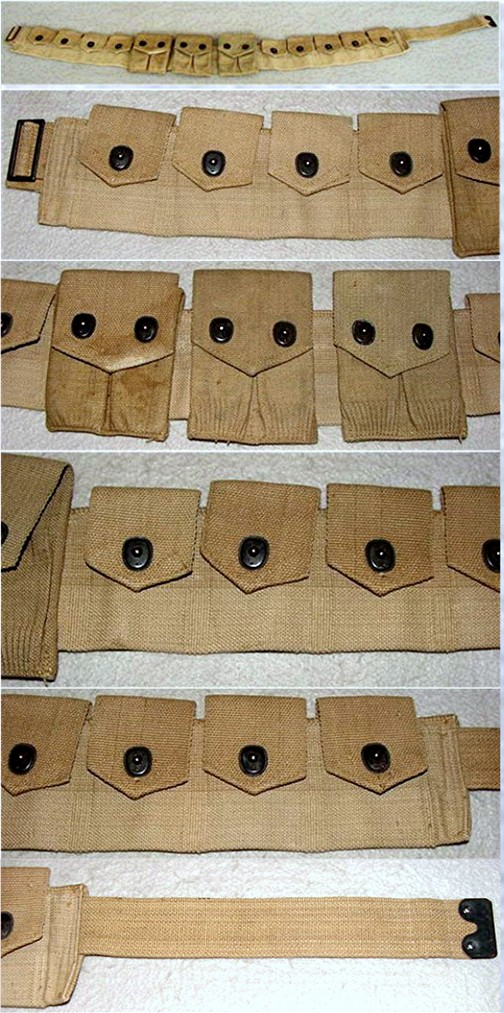|
NO. 2 MODEL 1917 CAVALRY BANDOLIER – LIKE NEW, UNISSUED –
MADE BY RUSSELL – A NOTABLE VARIANT: In
like new condition, this relatively scarce Model 1917
Cavalry Cartridge Bandolier was produced by the Russell
Manufacturing Company in Middletown, Connecticut, and it
presents as a very interesting variant. While it
is well known that the Model 1912 and 1917 Bandoliers
were modified by removing the pistol cartridge pockets
which were then replaced by a Model 1911 Automatic
Pistol Magazine Pouch, the configuration of this
bandolier is completely separate and apart from that
modification.
To explain why
this variant is so notable, some explanation on how
these bandoliers were woven may be helpful. The
standard configuration of the Model 1917 Bandolier
provided a total of twelve rifle cartridge pockets and
one set of three pistol cartridge pockets. The
bandolier body, with the integral rifle cartridge
pockets, was woven of one continuous piece of webbing.
The pocket flaps were then stitched into the open top
edge of the body. The three pocket pistol
cartridge carrier was woven as a separate unit, the
flaps were sewn to the pistol cartridge pockets in the
same manner as the rifle cartridge pocket flaps on the
body, and then the pistol cartridge carrier was sewn to
the center of the body as a single unit.
The three pocket
pistol cartridge carrier could be removed without
resulting in any damage to the integrity of the
bandolier body, however removing any of the integral
rifle cartridge pockets would severely damage the
longitudinal weave of the bandolier body and in effect
render the bandolier useless as the severed threads
would weaken the bandolier sufficiently that it would no
longer carry the weight of the cartridges.
This bandolier was
woven with a total of nine rifle cartridge pockets -
four on the left end and five on the right end - in
order to allow just enough space between the two sets of
rifle cartridge pockets to accommodate three Model 1917
Automatic Pistol Magazine Pouches. This
arrangement was an intentional design modification, done
at the time of the original weaving of the bandolier
body, and there is no evidence that this arrangement was
the result of this bandolier having been modified in the
field. The three magazine pouches are secured in
place by three female snaps set into the bandolier body
which are engaged by the matching male snap stud set
into the belt loop of the magazine pouch.
It stands to
reason that this variation of the Model 1917 Bandolier
must have been produced in some number, however limited.
Certainly, with the amount of labor necessary to plan
and modify the design, reset the looms, and produce this
variation, enough of them must have been ordered by the
army and eventually produced to make the overall
exercise worthwhile. That being said, to my
knowledge there are no surviving records or published
research which document the reasoning or intended issue
of this bandolier. Other than the obvious purpose
of providing the soldier with a greater number of loaded
pistol magazines, the history surrounding this variation
is mute. There are no unit issue stencils present
on the bandolier, nor does it exhibit a significant
amount of wear which would indicate limited use, however
the context in which this bandolier was found may
suggest which units received this variant. The man
who built the collection where this bandolier was found
had a definite interest in early 20th
Century Cavalry Machine Gun Companies. His
collection included a number of groupings of uniforms
and personal gear which were identified to various
cavalry machine gun companies, all dating in the
1916-1930 era. It is possible he acquired this
bandolier as part of one of those groupings.
Unfortunately, any such association was lost with his
passing.
This bandolier has survived in excellent condition, with
all of the lift the dot snaps intact, and with no
tearing or wear around the snaps. All of the
cartridge pocket flaps are intact, with none of the
flaps showing any wear. The original darkened
finish is present on all the metal fittings, showing
only minor wear in a few isolated spots from handling
and storage. The web billet is full length with the
proper unmarked darkened bronze tip on one end and the
proper frame friction buckle on the other.
The body shape features
the correct straight body which was produced by the Russell Manufacturing Co.
as a result of simplifying the bandolier design in 1917
in order to streamline the manufacturing process.
The inside of the
far left cartridge pocket flap has a faint ink stamped
RUSSELL in an oval cartouche and what appears to be “1918”. The inside
surface of the body, just under the magazine pouches, is
also ink stamped with a faint "RUSSELL" and what appears
to be "1918".
The three Model 1911 Magazine Pouches are all full form
and other than exhibiting some minor soiling from use
and storage, all are in excellent condition. The
lift the dot snaps are fully functional with no tearing
or wear present around the snaps, and the male snap stud
on the inside of the belt loops are all present.
As viewed left to right, the first pouch is manufactured
by Russell and the other two are manufactured by Mills.
The Russell pouch is company marked on the reverse of
the belt loop with the "Russell" in the oval and the two
Mills pouches are stenciled with the company patent
information on the underside of the flaps.
This
is a very interesting variant in excellent condition and
it would make a special addition to even the most
advanced collection of early 20th
Century woven cartridge belts and bandoliers. (0933)
$625

|

